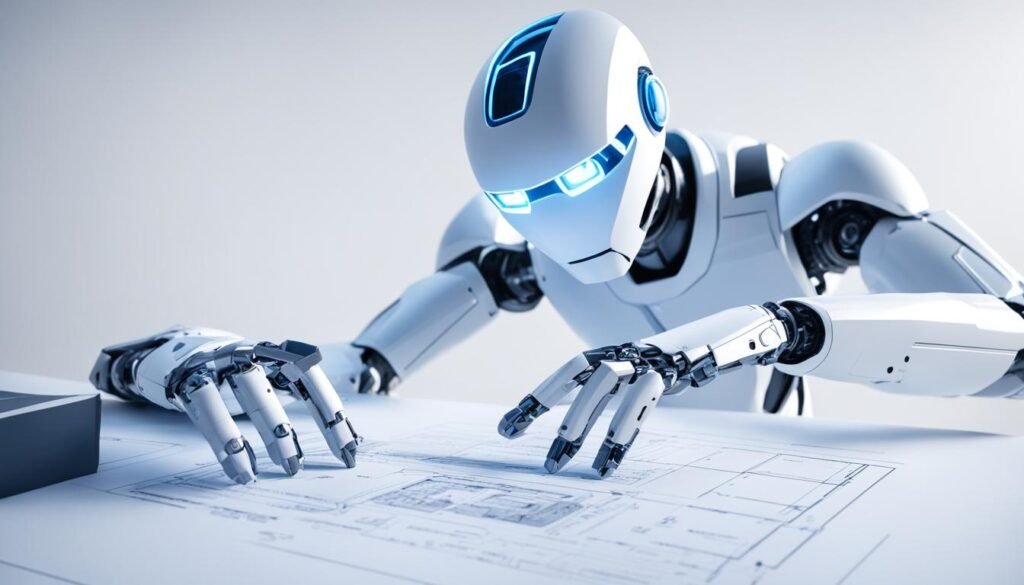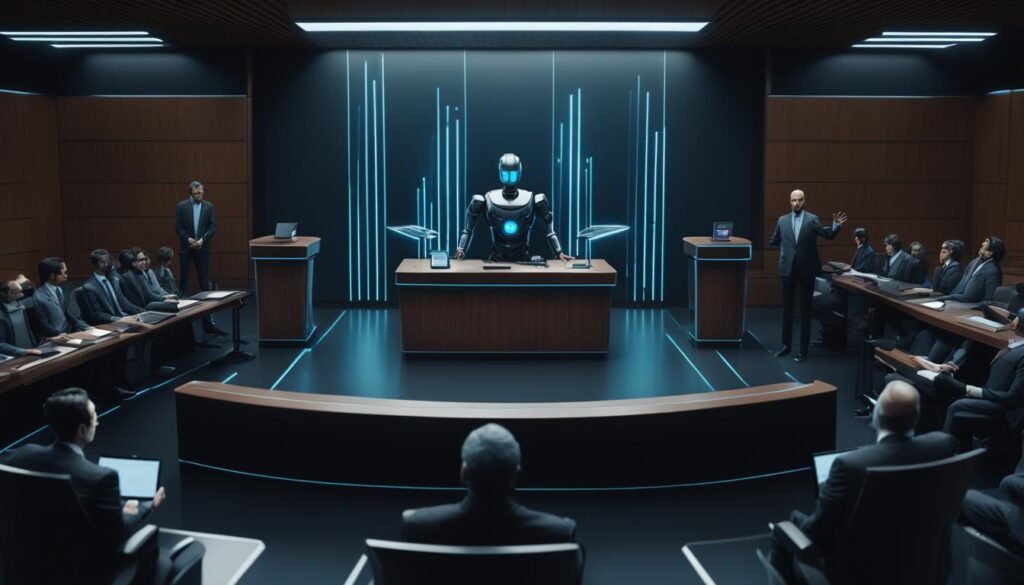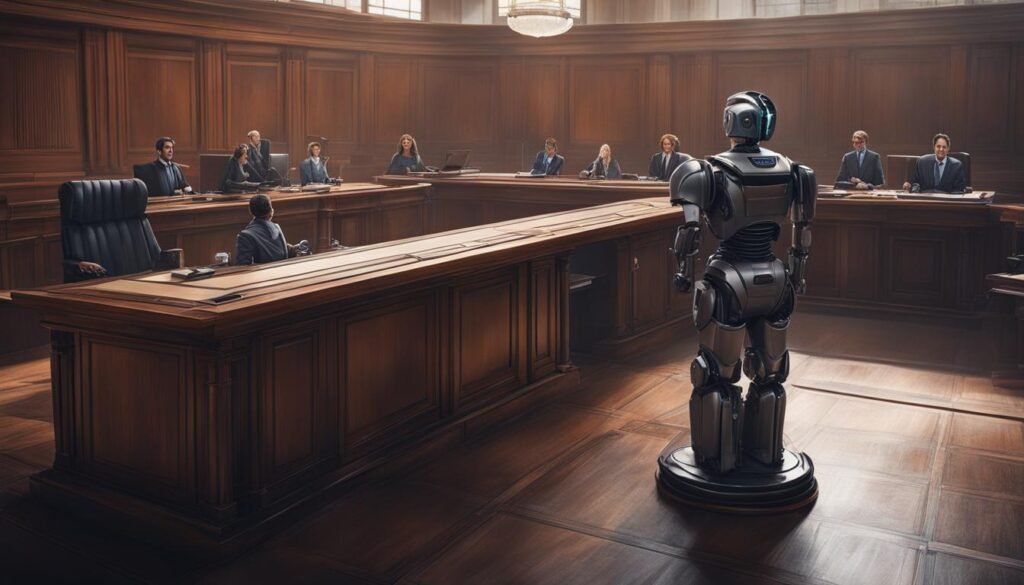Innovating Tomorrow: Legal Insights into AI Patents

Welcome to our article on patents in AI and intellectual property. As innovation pushes the boundaries of technology, the law is constantly evolving to keep up. For those exploring the fast-paced world of AI and its impact on intellectual property, navigating the legal landscape of AI patents can be a complex process with significant implications.
In this article, we will provide valuable insights into the legal aspects surrounding AI patents, including protecting intellectual property in the fast-evolving field of artificial intelligence. We will also explore unique challenges and opportunities that arise when seeking patent protection for AI technologies and showcase case studies from pioneering companies who have successfully protected their AI innovations and achieved significant milestones.
Key Takeaways:
- AI patents are a rapidly evolving area of intellectual property law, with unique challenges and opportunities.
- Patents play a significant role in protecting groundbreaking AI inventions and incentivizing innovation.
- Effective patent drafting strategies tailored for AI inventions are crucial in developing a strong patent portfolio.
- Enforcing AI patents and defending against infringement can be complex and requires a strategic approach.
- Monetizing AI inventions through licensing agreements and partnerships involves navigating the complex patent landscape and requires careful consideration and strategy.
Understanding AI Patents
Artificial intelligence (AI) is rapidly transforming various industries, including healthcare, finance, and manufacturing. As AI technologies continue to advance, patent protection becomes increasingly crucial for inventors and companies seeking to capitalize on their innovations and maintain a competitive edge in the market.
AI patents provide the legal foundation for inventors to safeguard their intellectual property assets. However, AI patents differ from traditional patents in their unique challenges and opportunities. While traditional patents focus on protecting human-created inventions, AI patents protect inventions created by machines using algorithms and data sets.
One of the challenges in seeking AI patent protection is the requirement to disclose sufficient details on how the invention works. This can be extremely difficult as AI technologies often involve complex algorithms and require significant technical expertise to explain.
On the other hand, AI patents offer several opportunities for innovators. For example, AI-powered inventions often have a wide range of applications across different industries, offering numerous opportunities for commercialization and licensing.
Overall, understanding AI patents is essential for those seeking to safeguard their AI innovations and capitalize on the limitless possibilities of the AI industry.
How AI Patents Differ from Traditional Patents
| Traditional Patents | AI Patents |
|---|---|
| Protect human-created inventions | Protect inventions created by machines using algorithms and data sets |
| Focus on the novelty and non-obviousness of the invention in light of the prior art | Require disclosure of sufficient details on how the invention works, which can be challenging for complex AI technologies |
| Often have a narrow scope of application | Can have a broad range of applications across different industries |
The Importance of Intellectual Property in AI Innovation
Intellectual property (IP) rights are essential for any organization seeking to innovate and develop advanced technologies. In the realm of artificial intelligence (AI), protecting IP is crucial to incentivizing and safeguarding groundbreaking inventions that have the potential to create lasting benefits for society.
A strong patent portfolio is key to protecting an organization’s AI innovations. Patents not only provide legal exclusivity over an invention, but also act as a powerful marketing tool, enhancing the overall value of an organization. The ability to secure a patent for an AI technology will also ensure that the organization has the exclusive right to use that technology for commercial purposes, thereby establishing a competitive edge over rivals.
Furthermore, IP protection of AI-related inventions is crucial to promoting ethical and socially responsible AI innovation. Through patents, inventors and organizations are incentivized to prioritize ethical considerations and socially beneficial outcomes in their creations.
In short, a robust IP strategy can be a driving force behind the development and commercialization of new and innovative AI technologies that can transform industries and improve people’s lives.
By leveraging proper IP protection, organizations can create a sustainable environment for future innovation and continue to drive breakthroughs in the field of AI.
Key Trends in AI Patents
As the field of artificial intelligence continues to evolve, so do the trends in AI patents. By keeping up with these trends, inventors and businesses can gain valuable insights into the future of AI and make strategic decisions regarding their patent portfolios. The following are some key trends to watch:
Emerging AI Technologies
New AI technologies are constantly emerging, from deep learning to natural language processing and beyond. As these technologies continue to evolve, they present exciting opportunities for AI patenting.
Did you know? As of August 2021, the United States Patent and Trademark Office has granted over 15,000 patents related to AI technologies.
Increased Patent Filings
The number of patent filings related to AI is increasing rapidly, with some estimates projecting over 40% annual growth in AI patent applications in the coming years. This increase in filings is driven by a combination of factors, including the expanding scope of AI applications and the growing importance of protecting intellectual property in the field.
Globalization of AI Patents
AI innovation is a global phenomenon, and as such, we are seeing a trend towards increased globalization of AI patents. Countries like China and South Korea are investing heavily in AI research and development, resulting in a surge of patent filings from these regions.
Challenges and Opportunities in AI Patenting
AI patents present a unique set of challenges and opportunities for inventors and their legal advisors. On one hand, AI technologies are rapidly advancing, providing new and exciting opportunities for innovative patent applications. On the other hand, the legal landscape surrounding AI patents is still being developed, presenting a plethora of challenges.
One significant challenge is ensuring that AI innovations meet the patentability requirements set forth by the US Patent and Trademark Office (USPTO). This can be difficult because many AI technologies are still in the early stages of development, making it challenging to establish their novelty and non-obviousness.
Another challenge lies in the complex and technical nature of AI patents, which can make them difficult to draft, prosecute, and enforce. To overcome these challenges, it is crucial to work with legal professionals who have a deep understanding of AI technologies and the nuances of patent law.
Despite these challenges, there are also many opportunities associated with AI patenting. The rapidly evolving nature of AI technologies makes it possible to gain an edge over competitors by securing patents for new and innovative AI applications. Furthermore, the potential impact of AI on numerous industries means that AI patents can have significant commercial value.
Overall, AI patenting involves navigating a complex and constantly evolving landscape. By taking advantage of the opportunities and overcoming the challenges, inventors and businesses can develop a strong patent portfolio in the dynamic field of AI.
Patentability Requirements for AI Inventions
Patentability is the key factor in protecting AI inventions from infringement. To qualify for a patent, an AI invention must meet certain criteria. Firstly, it should be novel, meaning that it should not have been disclosed publicly before. Secondly, it should be non-obvious, meaning that it should not have been an obvious invention to someone who is skilled in the field of AI.
The USPTO has set out additional criteria specific to AI inventions. AI innovations must have a “useful application” and statutory subject matter. They must also be able to produce a “concrete and tangible result,” tangible meaning that the results must be practical and measurable.
For example, a machine learning algorithm that predicts stock prices would meet the usefulness requirement as it has practical applications and produces a tangible result. However, an AI invention that can only generate random outputs would not meet this requirement.
Moreover, AI inventions must demonstrate more than just conventional steps to be considered non-obvious. Courts have set out a two-part determination for evaluating non-obviousness. Firstly, whether there is a motivation for a skilled person in the field to combine existing elements to produce the invention. Secondly, whether there would have been a reasonable expectation of success in making the combination.
In summary, to have a patent granted, an AI invention must meet the general criteria of novelty and non-obviousness, as well as the specific requirements established by the USPTO in relation to AI innovations. Understanding the eligibility criteria and having a sound knowledge of the legal requirements are essential in the pursuit of protecting AI inventions through patents.
Novelty and Non-obviousness in AI Patent Applications
When filing for an AI patent application, the concepts of novelty and non-obviousness are crucial. Novelty refers to the uniqueness of an invention, which means it must not have been previously published, disclosed, or patented. Non-obviousness, on the other hand, pertains to the level of creativity or ingenuity required to arrive at the invention.
Demonstrating the novelty and non-obviousness of AI inventions can be challenging, as these technologies often build on existing solutions or draw from a pool of preexisting data. However, it is essential to highlight the unique aspects of the invention that distinguish it from what has been previously done. An AI patent application must showcase the innovation that went into the algorithm development or the neural network design.
Additionally, as AI technologies evolve at a rapid pace, it is crucial to keep track of emerging solutions that could potentially render an existing patent application non-unique or obvious. Conducting a comprehensive search and analysis of prior art can help identify potential obstacles and enable applicants to refine their patent claims to satisfy the novelty and non-obviousness requirements.

Moreover, it is worth noting that there are specific legal nuances regarding the interpretation of novelty and non-obviousness requirements for AI inventions. For instance, the use of machine learning or AI algorithms that enable the system to learn and evolve over time can pose unique challenges in satisfying non-obviousness requirements. It’s crucial to work with a knowledgeable patent attorney or agent who understands these intricacies and can help navigate through the patent application process.
By effectively showcasing the novelty and non-obviousness of their AI patents, inventors can protect and leverage their innovations to gain a competitive advantage and propel their businesses forward.
Patent Drafting Strategies for AI Inventions
AI technology advancements are growing at an unprecedented rate, and it is crucial to have an effective patent drafting strategy to protect your unique invention. Drafting AI patent claims requires a deep understanding of the technology, the legal requirements of patentability, and the relevant case law.
To draft successful claims for AI inventions, start with identifying the technical features that make the AI technology innovative and novel. It is also essential to note that the claim language must be consistent with the U.S. Patent and Trademark Office (USPTO) guidelines and ensure compliance with patentability requirements, such as novelty and non-obviousness.
Describing the AI algorithms and processes in detail is necessary for successful patent drafting. For instance, using flowcharts and diagrams can aid in demonstrating how the AI invention works. It also makes the patent claims easier to understand for patent examiners.
The goals of patent drafting strategies for AI inventions are to clearly define the scope of the invention and exclude other similar technologies, utilize specific keywords and tech terms, and strategically use broad or narrow patent claims. Furthermore, it must be noted that using clear, precise, and unambiguous language is critical in avoiding confusion and potential litigation.
Overall, dive into the technical details of the AI invention and utilize clear and relevant language to ensure a robust patent application, protecting your AI invention while competing in the rapidly evolving technological landscape.
International Perspectives on AI Patents
Understanding the international landscape of AI patents is crucial for businesses and inventors operating in this field. As AI technologies continue to rapidly evolve, the legal frameworks governing their intellectual property protection vary widely across jurisdictions.
For example, China has developed a robust system of AI-related patents, with over 440,000 patent applications filed in the AI space since 2010. The Chinese government has also implemented national AI development plans, funding initiatives, and preferential policies to support domestic AI businesses and attract foreign investment.
In the United States, the USPTO has developed specific guidelines for patent examiners to evaluate AI-related patent applications. This includes considerations for the eligibility of AI inventions, as well as the specific requirements for demonstrating sufficient written description and enablement of AI-related claims.
Europe also offers a diverse range of patent frameworks for AI inventions, with varying levels of examination and enforcement across different countries. The European Patent Office has established guidelines for AI-related patents, including a focus on the technical character of the invention and the role of AI as a tool rather than an inventor.
All over the world, countries are grappling with the unique challenges posed by AI patents and the potential for these technologies to impact society in significant ways. As such, the importance of international collaboration and cooperation on AI patent regulation cannot be overstated in ensuring that AI continues to be an innovative and effective driver of progress.
AI Patents and Ethical Considerations
As the development of AI technologies continues to explode, so does the need to consider its potential ethical implications. The granting of patents for AI technologies may have far-reaching implications, both socially and ethically.
For instance, some worry that granting AI patents could lead to monopolies and prevent the development of low-cost or open-source alternatives. Furthermore, granting patents for AI technologies that are designed, for example, to replace human labor or to invade individual privacy may have significant ethical ramifications.
As such, it’s essential to take a balanced approach to AI patents, weighing the benefits against the potential societal impact and ethical dilemmas.
One possible solution is to consider ethical guidelines in the patent application process, similar to the approach taken in the pharmaceutical industry. Another option is to increase public awareness and engagement in the AI patent process, thereby encouraging more democratic and fair decision-making.
Case Study: Amazon’s Facial Recognition Technology
Amazon’s facial recognition technology, Rekognition, was granted multiple patents, sparking concerns around its ethical implications. Critics argue that the technology could be used to violate individual privacy and perpetuate biases.
“I’m increasingly concerned that we have a large number of companies competing to sell very dangerous and increasingly inaccurate facial recognition systems.” – Jay Stanley, Senior Policy Analyst at the ACLU
Amazon’s response is that the company has ethical guidelines in place for using its facial recognition technology responsibly. The company claims to have consulted with stakeholders to ensure that their technology is used within predefined ethical boundaries. Some industry experts suggest that greater transparency and collaboration between AI innovators, subject experts, and society at large are necessary for ethical AI innovations to emerge.
Enforcement of AI Patents
Innovative AI inventions require strong patent protection to thrive. However, with the increasingly competitive AI landscape, the risk of infringement and misappropriation of AI patents is greater than ever before. Businesses and inventors must be aware of the avenues available for enforcing their AI patents and defending against infringement.
Enforcement of AI patents requires navigating a complex legal landscape and identifying the appropriate legal strategies to protect intellectual property rights. This can involve litigation, licensing agreements, and other measures to prevent infringement. It is crucial to have a comprehensive understanding of the legal remedies available and the challenges and strategies associated with each approach.
“Enforcement of AI patents requires navigating a complex legal landscape and identifying the appropriate legal strategies to protect intellectual property rights.”
When enforcing AI patents, it is important to conduct in-depth legal research, evaluate the strength of the patent, and consider the impact of the enforcement strategy on your business and stakeholders. Litigation can be costly and time-consuming, while licensing agreements may limit the scope of your patent protection. Therefore, it is essential to work with experienced legal professionals who can guide you in making informed decisions and help you develop a comprehensive enforcement strategy that aligns with your business goals.
Defending Against Infringement
In addition to enforcing AI patents, it is equally important to defend against infringement. This involves identifying and addressing instances of infringement, whether through litigation or other means. It is also crucial to conduct regular patent searches and monitor the market to detect potential infringement early on.
To defend against infringement of AI patents, it is important to have a strong patent portfolio and comprehensive legal strategy that takes into account the unique challenges of AI technology. This can involve leveraging both defensive and offensive legal tactics to protect your intellectual property rights and maintain a competitive edge in the AI space.

Enforcement and defense of AI patents are complex processes that require expertise and experience. By developing a comprehensive legal strategy and working with trusted legal professionals, businesses and inventors can protect their AI inventions and maximize their opportunities for success.
Patent Strategies for Startups in the AI Space
For startups operating in the AI space, protecting their inventions with patents can be a critical step for success. With the right patent strategies, startups can gain a competitive advantage and attract investment opportunities. Here are some practical patent strategies to consider:
- File early and often: In the fast-paced world of AI innovation, filing patent applications early and often can be crucial. This ensures that your inventions are protected while giving you the flexibility to continue developing and improving them.
- Focus on high-value areas: Depending on the nature of your startup, you may want to prioritize certain areas of AI innovation that have higher potential value. This can help you focus your patent efforts and allocate resources more efficiently.
- Collaborate with other startups: By collaborating with other startups in the AI space, you can pool resources and knowledge to increase your competitive edge. This can also lead to joint patent ventures that can be beneficial for all parties involved.
- Consider licensing: In some cases, it may make sense to license your AI inventions to existing companies rather than trying to compete with them directly. This can provide a valuable revenue stream and allow you to scale your business more effectively.
When developing patent strategies for your startup, it is important to consult with experienced intellectual property attorneys who are well-versed in the nuances of AI patents. By leveraging their knowledge and expertise, you can help ensure the success and longevity of your company.
Patent Litigation and AI
When it comes to patent litigation, AI presents a unique set of challenges. AI technologies are complex and constantly evolving, making it difficult to define and protect proprietary rights. In some cases, AI may even create its own inventions, leading to questions regarding inventorship and ownership.
One example of a recent AI patent dispute is the case of BrainChip Inc. v. Vkansee Technology LLC, where BrainChip accused Vkansee of infringing on its patent for facial recognition technology. In its defense, Vkansee argued that its technology was based on a machine learning algorithm that developed its own method of facial recognition, which should not be considered infringement.
Another challenge in patent litigation involving AI is the lack of clear legal precedent. Many AI technologies are new and unique, making it difficult for courts to apply established patent laws and regulations. This can lead to inconsistent rulings and uncertainty for patent holders.
Despite these challenges, patent litigation remains an important avenue for protecting AI innovations. Companies and inventors must be diligent in patent drafting and filing, as well as in enforcing their patent rights in the event of infringement.

“AI technologies are complex and constantly evolving, making it difficult to define and protect proprietary rights.”
Licensing and Commercialization of AI Patents
Monetizing AI inventions can be a lucrative undertaking for companies and inventors. Licensing agreements and partnerships are popular strategies that can be employed to commercialize AI patents. Licensing agreements allow the licensor to retain ownership of the patent while granting the licensee the right to use the patented technology for a specified period of time and under certain conditions. In exchange for this right, the licensee pays the licensor a licensing fee.
Partnerships, on the other hand, involve collaboration between two or more entities to develop, market, and sell AI products or services. These partnerships can be established between companies operating in different sectors or between companies operating in the same industry.
However, licensing and commercializing AI patents come with a unique set of challenges. For instance, it can be difficult to determine the value of an AI patent. Additionally, determining the scope of the licensing agreement or the partnership can be complex. As such, it is essential to seek legal guidance from experts in the field of AI patents to navigate these challenges.
Strategies for Successful Licensing and Commercialization
To ensure a successful licensing or commercialization strategy, it is important to have a clear understanding of the market demand for the AI technology, as well as the availability of competing technologies. Additionally, carefully crafting licensing agreements and partnership agreements can help mitigate disputes and disagreements in the future.
“We have seen many startups fail when it comes to licensing and commercializing their AI patents. It is important to approach this process with diligence and caution, seeking expert guidance where necessary.”
Lastly, it is crucial to continually evaluate the licensing and commercialization strategy to ensure that it meets the evolving needs of the market and aligns with the overall business strategy.
AI Patents: Case Studies and Success Stories
Real-world case studies and success stories of AI patents are shining examples of how innovative companies and inventors have protected their AI innovations and achieved significant milestones. By studying these stories, we gain valuable insights and learn from their successful strategies.
Case Study 1: IBM’s Watson Virtual Assistant
In 2014, IBM secured a patent for “Question-answering system and method including cross-corpus analysis” for its Watson virtual assistant. This breakthrough invention allowed Watson to understand the nuances of human language and context and find relevant information quickly. Due to the patent, IBM’s Watson achieved significant success, becoming a leading virtual assistant in healthcare, finance, and education industries. The patent protection allowed IBM to capitalize on the commercial possibilities of Watson and cement its leadership in AI technology.
Case Study 2: Google’s Self-driving Car Technology
Google’s self-driving car technology is a prime example of how AI patents have revolutionized the automotive industry. Since 2011, Google has obtained numerous patents to protect its self-driving car technology, which uses AI to navigate roads and avoid collisions. By 2020, Google’s parent company Alphabet had established Waymo, a subsidiary that focuses solely on developing self-driving technology. The patents allowed Waymo to license its technology to car manufacturers and other companies, making significant strides in transforming the automobile industry.
Success Story: NVIDIA Corporation
NVIDIA Corporation’s investment in AI patents has paid off significantly. The company now holds one of the largest patent portfolios in AI, with over 8,000 patents and patent applications. NVIDIA’s focus on patent protection has allowed it to expand its business operations around the world and become a leader in AI technology. NVIDIA’s invention of GPU technology (Graphics Processing Unit) has been a significant milestone in AI technology, and its patent portfolio has helped establish the company as a pioneering force in the field.

These case studies and success stories underline the importance of protecting AI innovations through patents. By seizing the opportunities and navigating the challenges in AI patenting, companies and inventors can have their innovations recognized, safeguarded, and monetized to drive economic growth, competitive advantage, and societal progress.
Conclusion
In conclusion, navigating the world of AI patents requires a thorough understanding of the unique challenges and opportunities that arise in this rapidly evolving field. Protecting your intellectual property in AI innovation is crucial, as it incentivizes further advancements and ensures that your groundbreaking inventions remain secure.
As explored in this article, there are specific patentability requirements for AI inventions, including demonstrating novelty and non-obviousness, drafting effective claims, and navigating the complex patent landscape. To stay ahead of the curve, it is important to analyze the latest trends in AI patents and understand the varying approaches and regulations governing AI patents in different jurisdictions around the world.
While patenting AI technologies presents ethical considerations, it also offers potential for successful licensing and commercialization. Startups in the AI space can leverage intellectual property to gain a competitive advantage, and companies can defend against infringement through available avenues for enforcement.
Through real-world case studies and success stories, we have seen the significant impact of successful AI patents and the role they play in shaping the future of innovation. By staying informed and proactive in protecting your AI inventions, you can ensure that you are well-positioned to succeed in this exciting, ever-changing field.
FAQ
What are AI patents?
AI patents refer to the intellectual property rights granted to inventions related to artificial intelligence. These patents protect the unique algorithms, machine learning methods, and other AI technologies used to develop innovative AI systems and applications.
How do AI patents differ from traditional patents?
AI patents differ from traditional patents because they involve inventions that incorporate artificial intelligence technologies. Traditional patents cover a wide range of inventions, while AI patents specifically protect AI algorithms, machine learning models, and other AI-related innovations.
Why is intellectual property important in AI innovation?
Intellectual property is crucial in AI innovation because it incentivizes inventors to invest time, resources, and effort into developing groundbreaking AI technologies. Patents encourage inventors to disclose their innovations to the public while granting them exclusive rights to profit from their inventions for a limited period of time.
What are the key trends in AI patents?
The field of AI patents is experiencing rapid growth in various sectors, including healthcare, autonomous vehicles, and natural language processing. Emerging technologies such as deep learning, computer vision, and robotics are shaping the future of AI patents and driving innovation in these fields.
What challenges and opportunities are associated with AI patenting?
AI patenting presents both challenges and opportunities. Challenges include navigating the complex technical aspects of AI inventions, addressing the patentability requirements specific to AI, and dealing with potential ethical considerations. Opportunities arise from protecting valuable AI innovations, gaining a competitive advantage, and monetizing AI patents through licensing and commercialization.
What are the patentability requirements for AI inventions?
To obtain a patent for an AI invention, it must meet the general patentability requirements, such as novelty, non-obviousness, and industrial applicability. Additionally, AI inventions must demonstrate technical advancement and solve a technical problem using AI technologies.
What is the role of novelty and non-obviousness in AI patent applications?
Novelty and non-obviousness are crucial requirements for AI patent applications. Novelty means the invention must be new and not already disclosed to the public. Non-obviousness refers to the invention’s inventive step, meaning it involves a significant advancement over existing technologies that would not be obvious to someone skilled in the field.
What are patent drafting strategies for AI inventions?
Patent drafting strategies for AI inventions involve effectively describing the technical aspects of the AI innovation, including the algorithms, machine learning methods, and specific AI components. It is essential to draft claims that cover the unique features and functionalities of the AI invention.
How do international perspectives differ in AI patents?
International perspectives on AI patents can vary in terms of legal frameworks, examination standards, and patentability criteria. Different jurisdictions have their own rules and practices for granting AI patents, which may impact the global protection and enforcement of AI inventions.
What are the ethical considerations surrounding AI patents?
AI patents raise ethical considerations due to the potential social impact and ethical dilemmas associated with certain AI technologies. Granting patents for AI inventions that have significant societal implications requires careful assessment of potential consequences and balancing the interests of innovation and public welfare.
How can AI patents be enforced?
AI patents can be enforced through legal actions, such as filing infringement lawsuits against those using the patented technology without permission. Enforcement strategies involve proving infringement, defending against challenges to the validity of the patent, and seeking remedies, including damages and injunctions, in court.
What patent strategies are recommended for startups in the AI space?
Startups in the AI space should consider developing a comprehensive patent strategy to protect their innovative AI technologies. This may involve conducting prior art searches, filing provisional patents, partnering with experienced patent attorneys, and leveraging their patents for strategic business purposes.
How does patent litigation intersect with AI?
Patent litigation involving AI technologies presents unique complexities, such as the need to define the boundaries of AI-related inventions and evaluate the technical aspects of the contested patents. Courts and legal professionals must grapple with the technical nuances of AI when resolving patent disputes.
How can AI patents be licensed and commercialized?
AI patents can be monetized through licensing agreements and commercialization efforts. Licensing allows others to use the patented technology in exchange for royalty payments, while commercialization involves directly marketing and selling the AI inventions or partnering with companies to develop and distribute AI products and services.
Are there any case studies or success stories of AI patents?
Yes, there are numerous case studies and success stories related to AI patents. Many pioneering companies and inventors have successfully protected their AI innovations through patents and achieved significant milestones in the AI industry. These case studies provide valuable insights into the potential of AI patents.


